A look back over the Newcastle Helix development
Explore the newest addition to our Newcastle city centre campus: Newcastle Helix
The 24-acre site is situated where the former Scottish and Newcastle Brewery once stood. Newcastle University, in partnership with Newcastle City Council and Legal & General, have been developing the site over several years to deliver a £350M urban regeneration project.
Bringing together academia, communities, business, industry and the public sector, this unique site is a testbed for innovative technologies and solutions tackling some of the most pressing challenges facing cities around the world, such as flooding, resilient infrastructure and energy.
The end of an era for Scottish and Newcastle Brewery
The famous Newcastle Brown Ale began production at the brewery way back in 1927. To mark the closure in 2005, 3,000 commemorative bottles were produced and given to employees. Production of the ale continued on Tyneside for a period of time, with Scottish and Newcastle acquiring the Federation Brewery in Dunston, Gateshead.
The European Protected Geographical Indication order, introduced in 1996 to restrict brewing of Newcastle Brown Ale to Newcastle upon Tyne, was revoked in 2006. Shortly after, brewing moved to Tadcaster, North Yorkshire in 2010. Today, Newcastle Brown Ale is also brewed in the Netherlands and America.
The Scottish and Newcastle Brewery was demolished in June 2008 when local hero Sir Bobby Robson was invited to press the button which triggered the controlled explosion of the buildings.
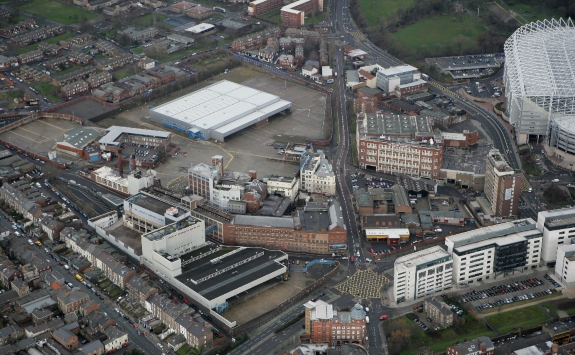
.jpg)
A changing name
During its lifespan, the site has been known as Newcastle Science City, Science Central and Newcastle Helix.
In 2005, Newcastle was one of six cities designated a Science City by the then UK Chancellor of the Exchequer, Gordon Brown. This government strategy aimed to place science, technology and innovation as the engine of economic growth, allowing the UK to compete in an increasingly competitive global market.
As a result, the Scottish and Newcastle Brewery site was purchased by the Newcastle Science City partnership consisting of Newcastle University, Newcastle City Council and One NorthEast.
When the funding arrangements for the partnership were due to come to an end in March 2015, Newcastle University and Newcastle City Council decided to continue the partnership together, with the site becoming known as Science Central.
In June 2016, Legal & General joined the partnership as a long-term investor to work collaboratively on the urban regeneration project. A decision to re-brand was made and the site became known as it is today, Newcastle Helix.
The Core
The Core was the first building to open on the site in Winter 2014, providing a workspace for knowledge-based and research-led SME organisations who are operating in sectors addressing future city challenges. Its design incorporates a 27m tall living wall, planted sedum roofs, a rainwater harvesting system, and bee hotels.
The opening of The Core marked the first phase of the development’s completion. In recognition, a commemorative stone was laid by the then Minister for Universities, Science & Cities, the Rt Hon Grey Clark MP, on Wednesday 25 February 2015 to officially open Science Central.
.jpg)
The Key
Neighbouring The Core, The Key opened in 2015. This was the first of the University’s buildings to open on the site.
Civil Engineering at Newcastle University has a particular specialism in the simulation of textile and rigid composite structures. As such, The Key is dedicated to world-leading structural and materials engineering research and exploring how technology can help to lower energy consumption and make buildings cheaper to run.
The fabric used for the roof canopy is similar to the roof developed for the 2012 Olympic Stadium by the Newcastle University team.
.jpg)
Urban Sciences Building
The Urban Sciences Building (USB) was the second University building to open on the site in September 2017.
The USB is home to the School of Computing, as well as the National Green Infrastructure Facility, the National Centre for Energy Systems Integration, the Siemens MindSphere Laboratory and the UK’s first Urban Observatory.
This intelligent building is fitted with more than 1,000 sensors connecting its walls, windows and fitting and is collecting data from across the city. The vision for the USB was to create a living laboratory where our computing scientists and engineers can work together to address the question of how an old industrial city like Newcastle can be re-engineered so that it becomes an exemplar all over the world of a sustainable city for the future. It is revolutionising how cities will look, behave and interact within their environment by providing an evidence base to be used by city planners and future developers.
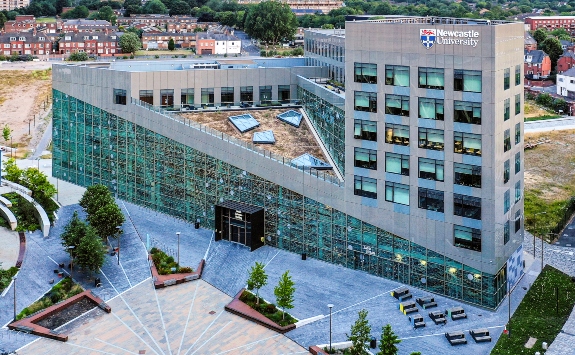
The Biosphere
The Biosphere opened in November 2018 to provide laboratory and office space dedicated to life science innovation, research, development, and commercialisation. The building’s design challenges traditional lab culture, with collaborative areas and modular workspaces.
It is now operating at full capacity with more than 20 businesses, including several Newcastle University Spin Out companies. Businesses who are based there are working on solutions for some of society’s most pressing global challenges, such as COVID-19, cancer, and climate change.
The Frederick Douglass Centre
The Frederick Douglass Centre is Newcastle University’s learning and teaching centre, mainly for the School of Computing and Newcastle University Business School. It opened in 2019 and contains a 750 capacity lecture theatre.
The building is named in honour of social reformer, abolitionist and activist-author Frederick Douglass.
An anti-slavery campaigner – and at that time, an escaped slave himself – Frederick Douglass came to Newcastle in 1846 as part of a lecture tour of Great Britain and Ireland, during which he spoke to packed halls and churches about slavery in his native U.S.
The building was officially opened by Frederick Douglass’s great-great-great grandson, Kenneth B Morris Jr, on 13 November 2019, exactly 52 years after Newcastle University awarded Dr Martin Luther King Jr an honorary degree.
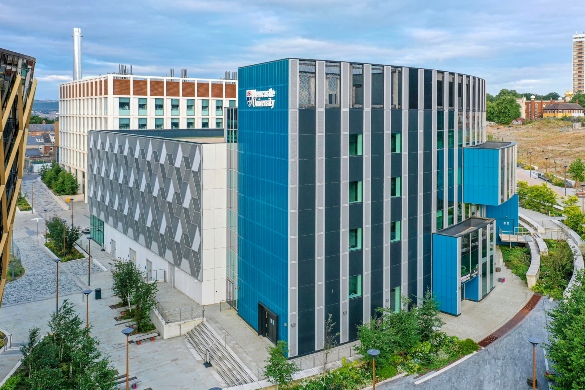
The Catalyst
Construction of The Catalyst was completed in October 2019. The National Innovation Centre for Ageing resides in the building working with research specialists, businesses and the public to facilitate the commercialisation of key products, services and technologies to help people live better, longer lives. As well as the National Innovation Centre for Data working on opportunities offered by the explosion in digital data.
The design is based around ease of navigation for visitors who may have visual impairments, disabilities or walking aids, including areas designed to be dementia friendly. The Wolfson TED Talk theatre’s tiered seating fully caters for the elderly and disabled, with wide aisles that allow the seat bases to be permanently fixed in the down position.
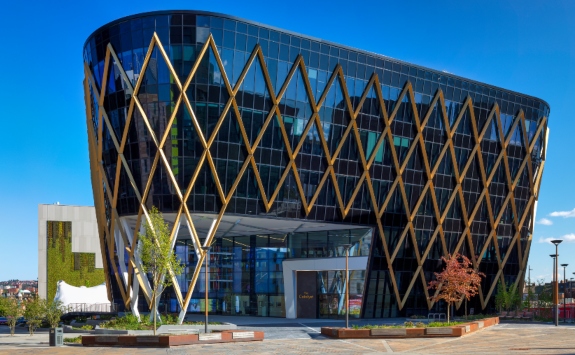
The District Energy Centre
The District Energy Centre opened in January 2020 as a centralised energy system for Newcastle Helix. The centre provides affordable heating to all businesses and homes on the site via a network of underground pipes. Non-residential properties on the site also benefit from a cooling system and a bespoke electricity supply. It also feeds the fast-charging points in the site’s six-story carpark, The Garage.
It is expected to provide carbon emission savings in excess of 30,000 tonnes per year for the next 40-years, contributing to Newcastle City Council’s commitment to net zero carbon emissions by 2030.
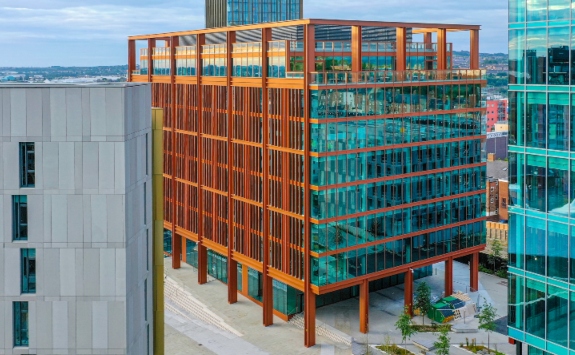
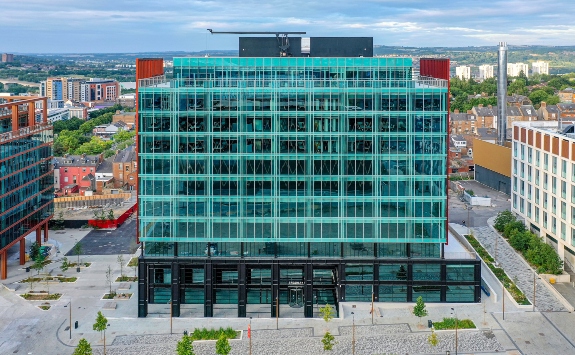
The future of Newcastle Helix
The next stage of the Newcastle Helix site involves the development of residential areas. This includes 450 solar-powered homes, some with built-in smart technology and moveable partitions allowing the homes to be configured to suit the changing needs of different households as they age. As well as a build-to-rent apartment block called No. 9.
Planning permission for a Moxy Hotel was also approved by Newcastle City Council in 2021.